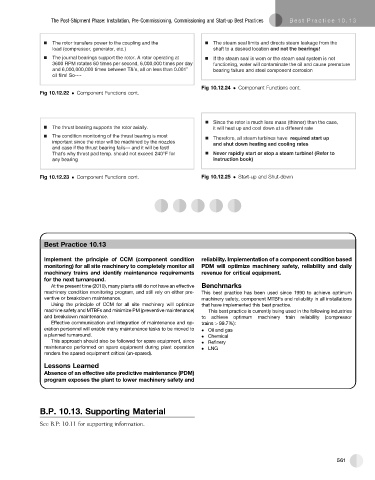Page 590 - Subyek Teknik Mesin - Forsthoffers Best Practice Handbook for Rotating Machinery by William E Forsthoffer
P. 590
The Post-Shipment Phase: Installation, Pre-Commissioning, Commissioning and Start-up Best Practices Be st Practice 1 0.13
The rotor transfers power to the coupling and the The steam seal limits and directs steam leakage from the
load (compressor, generator, etc.) shaft to a desired location and not the bearings!
The journal bearings support the rotor. A rotor operating at If the steam seal is worn or the steam seal system is not
3600 RPM rotates 60 times per second, 6,000,000 times per day functioning, water will contaminate the oil and cause premature
and 6,000,000,000 times between T&’s, all on less than 0.001” bearing failure and steel component corrosion
oil film! So----
Fig 10.12.24 Component Functions cont.
Fig 10.12.22 Component Functions cont.
Since the rotor is much less mass (thinner) than the case,
The thrust bearing supports the rotor axially. it will heat up and cool down at a different rate
The condition monitoring of the thrust bearing is most Therefore, all steam turbines have required start up
important since the rotor will be machined by the nozzles
and shut down heating and cooling rates
and case if the thrust bearing fails--- and it will be fast!
That’s why thrust pad temp. should not exceed 240°F for Never rapidly start or stop a steam turbine! (Refer to
any bearing instruction book)
Fig 10.12.23 Component Functions cont. Fig 10.12.25 Start-up and Shut-down
Best Practice 10.13Practice 10.13
Best
Implement the principle of CCM (component condition reliability. Implementation of a component condition based
monitoring) for all site machinery to completely monitor all PDM will optimize machinery safety, reliability and daily
machinery trains and identify maintenance requirements revenue for critical equipment.
for the next turnaround.
At the present time (2010), many plants still do not have an effective Benchmarks
machinery condition monitoring program, and still rely on either pre- This best practice has been used since 1990 to achieve optimum
ventive or breakdown maintenance. machinery safety, component MTBFs and reliability in all installations
Using the principle of CCM for all site machinery will optimize that have implemented this best practice.
machine safety and MTBFs and minimize PM (preventive maintenance) This best practice is currently being used in the following industries
and breakdown maintenance. to achieve optimum machinery train reliability (compressor
Effective communication and integration of maintenance and op- trains > 99.7%):
eration personnel will enable many maintenance tasks to be moved to Oil and gas
a planned turnaround. Chemical
This approach should also be followed for spare equipment, since Refinery
maintenance performed on spare equipment during plant operation LNG
renders the spared equipment critical (un-spared).
Lessons Learned
Absence of an effective site predictive maintenance (PDM)
program exposes the plant to lower machinery safety and
B.P. 10.13. Supporting Material
See B.P: 10.11 for supporting information.
561

